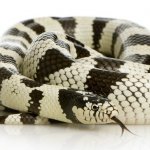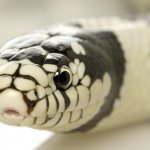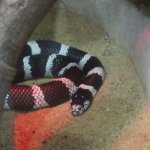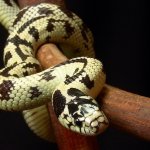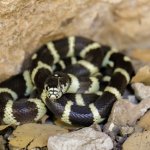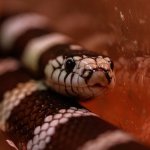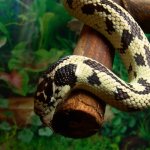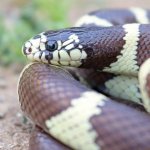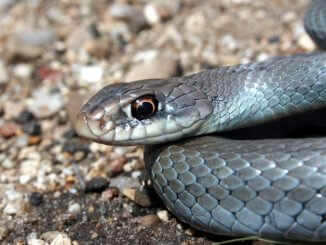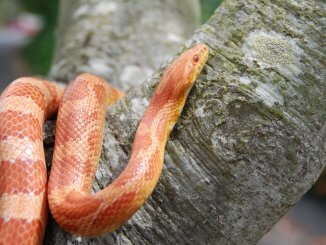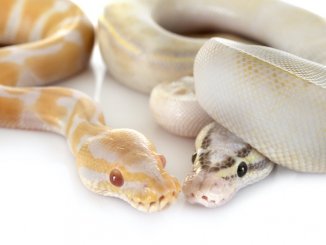California Kingsnakes are one of the most popular pet snakes. They are docile, easy to care for and cheap.
Kingsnakes can cost less than $100 and come in a wide variety of morphs and colorations. The most popular are the banana and striped morphs.
For someone looking to adopt their first snake this species makes an excellent pet. They are simple to care for, thrive in in a variety of habitat setups and have a peppy personality.
Despite being a beginner snake there are still some important considerations to make.
If you want to make sure your pet has the perfect enclosure, proper diet and lives a healthy life then keep reading…

California Kingsnake Overview
The California Kingsnake is originally from the state of California.
Interestingly this species of snake is immune to most snake venoms. Because of their immunity they are a predator of many venomous species. They are known as the “king” of snakes and hunt pit vipers.
First discovered in 1835 these snakes now inhabit most of the western United States.
California Kingsnakes can be found in forests, prairies, deserts and many other ecosystems.
The natural color for this snake is alternating white and black bands. However, there are some morph variations of whites, yellows, browns, and blacks in different patterns.
Are California Kingsnakes Good Pets?
Many new keepers love this species for its docile yet outgoing temperament. They are also a hardy snake and thrive in captivity.
In captivity they do well on a diet of thawed frozen mice and do not need a complicated setup. They require a basking spot, a daytime temperature of 80 degrees and a secure 40-gallon tank.
Pros
- Easy to care for and does not require a difficult tank setup.
- They are very cheap when compared to other species and cost less than $100.
- There are many color and pattern morph variations available.
Cons
- Their eager nature during feeding can lead to accidental bites.
- Kingsnakes can grow to four feet in length and require a larger tank most pet snakes.
- Juveniles can be hard to handle due to their flighty temperament.
Species Appearance
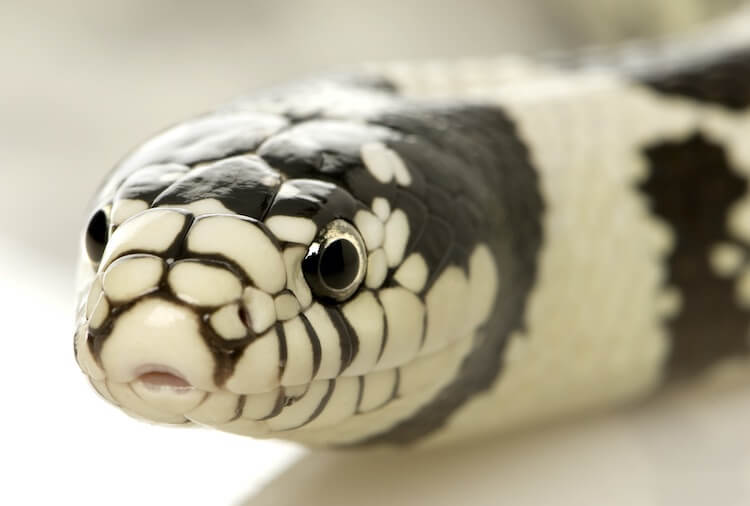
California Kingsnakes are a subspecies of the common Kingsnake.
They are usually a combination of a white or yellow and a darker black or brown base color. Their scales have a distinct shiny and smooth appearance.
The easiest way to identify any California kingsnake is by their white face.
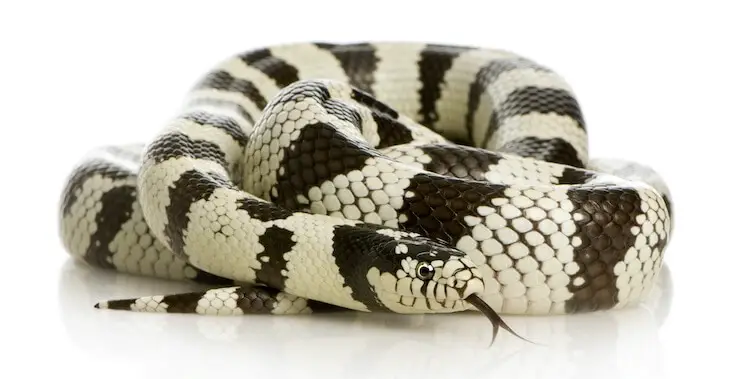
California Kingsnake Morphs
This snake has many color and pattern morphs.
Striped California Kingsnakes are common with a pattern of black and white alternating bands and a white face. There are no obvious color differences between males and females.
There are over 50 known California kingsnake morphs. The most popular morphs are:
- High Yellow Banana
- Albino
- Chocolate
- Lavender
- Reverse Stripe
- Black and White Striped
- High White
All of these morphs are either white or yellow on a brown or black base color arranged in either horizontal bands or vertical stripes.
California Kingsnake Size
Hatchlings measure between eight to ten inches in length. Generally this species grows to an adult size of three to four feet in length within three years.
Occasionally some Kingsnakes grow up to six feet in length, however this is rare.
Females are normally larger than their male counterparts.
Adults rarely weigh more than four pounds and they have a slimmer body than other popular pet snakes such as Boas. Their heads are only slightly broader than the rest of their bodies.
California Kingsnake Care Guide
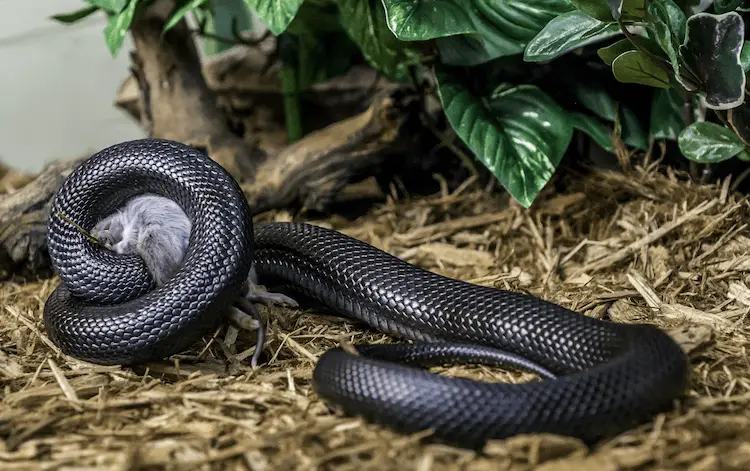
California Kingsnake Diet
Every species of snake is carnivorous.
This snake is not fussy when it comes to their diet.
Kingsnakes are a type of constrictor snake so they squeeze the life out of their prey before eating it. In the wild they will eat any small organism or animal they can catch:
- Birds
- Frogs
- Lizards
- Rodents
- Snakes
In captivity your pet snake will eagerly eat almost any meal offered to him.
It is important that you do not feed them when they are actively shedding.
You should also not offer live prey to avoid your snake from being injured. All prey should be bought frozen and thawed before being fed. California Kingsnakes can be fed a diet of mice, chicks and lizards.
Hatchlings should be fed one prey item each week.
Adults can be transitioned over to being fed once every 14 days.
Owners should be aware that they can be eager eaters. You should use caution when feeding them so that you are not mistakenly bitten.
If your snake ignores the prey for more than two hours then remove it from the cage. Try and feed new prey a few days later.
It is important not to attempt to handle a Kingsnake before or after feeding for at least 24 hours.
California Kingsnake Lifespan
California kingsnakes can develop health issues if their enclosure is not setup properly or cleaned regularly. Their lifespan varies a lot in captivity but it is normally between 20 and 30 years.
Respiratory infections are common in this species.
Mouth breathing and wheezing are typically the first signs of respiratory infection.
Respiratory infections are normally caused by temperatures that are too low. If these infections are caught early then raising the enclosure’s temperature can resolve it in a matter of days.
However if these infections are chronic then antibiotics will be necessary.
Another common condition for pet snakes is mouth rot (i.e. an infection of their gums).
Mouth rot is typically associated with an inflamed and red mouth with pus. It also requires antibiotics.
Finally if their tank is not cleaned regularly they can be exposed to parasites such as worms, ticks and mites. If your snake has a parasitic infection it is important to provide antiparasitic treatment and regularly disinfect their enclosure. This will help to eliminate any residual parasites and prevent re-infection.
Signs They Are Healthy
- Regularly shedding in a single piece.
- Their eyes, ears, nose, and mouth are clear of debris.
- Healthy appetite and eagerly accept food.
- Alert and active.
Sickness Symptoms
- Watery feces that are not well formed.
- Sunken and cloudy eyes.
- Eating and drinking irregularly and losing weight.
- Breathing with their mouths open.
California Kingsnake Enclosure
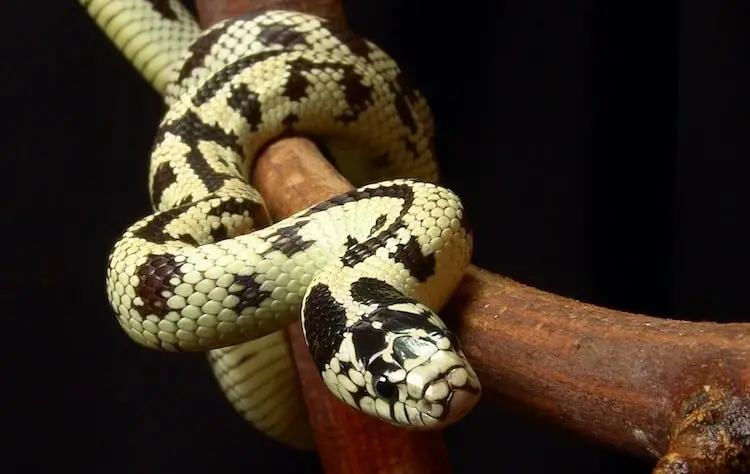
The California Kingsnake thrives throughout the entire state of California apart from the extreme northeast redwood forest.
They are also found in several other western states such as Oregon, Nevada, Arizona, Utah and Colorado.
One of the reasons they make excellent pets is their ability to adapt to new environments. This species thrives in a variety of different habitats from forests to grasslands and even deserts.
Kingsnakes are typically active during the daytime.
As juveniles they can be extremely active but are more docile as adults. They spend most of their time on the ground but occasionally will climb small trees and bushes.
Their enclosure should include a dry substrate and a few logs of varying heights.
Setup
Wooden vivariums work best for this species as they provide a good amount of insulation. Glass tanks are also a good option but the temperature will need to be routinely monitored.
Hatchlings can live in a 10-gallon tank but adults need a 40-gallon wooden vivarium:
- Tank Type: wooden.
- Tank Size: 40-gallons.
- Lighting: basking lamp and natural lighting.
- Substrate: aspen .
It is important not to overcrowd their enclosure with too many branches and decorations as they like to spend most of their time on the ground.
A few logs and a rock for a basking spot is all that’s required.
Temperature and Humidity
They need a basking spot that is slightly hotter than the rest of their enclosure.
Their enclosure should be set to 80 degrees during the day and the basking spot closer to 90 degrees.
They should have a basking light but do not need specific UVA or UVB lights provided natural light can reach their enclosure.
At night the temperature should drop to around 72 degrees.
Under tank heaters can be used to maintain 72 degrees. However make sure to regulate them frequently as these heating systems can cause traumatic burns if not used properly. The under tank heater should only be placed under one third of the vivarium. This will prevent overheating the vivarium.
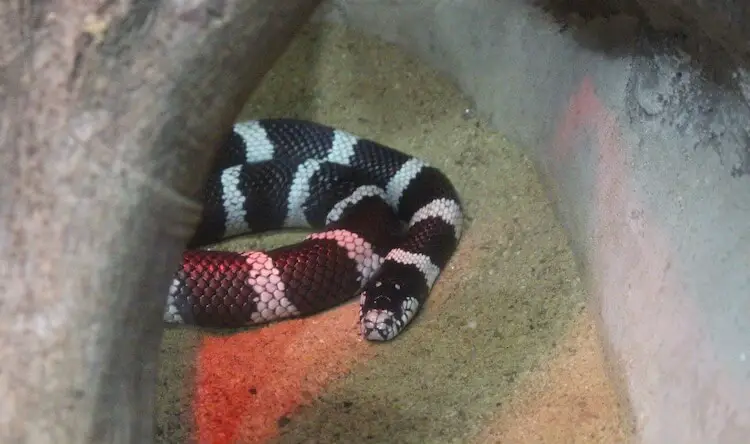
Their substrate should be dry and not able to absorb moisture. This will help keep their skin clean and healthy.
Aspen shavings are the best substrate for California Kingsnakes. Aspen shavings closely mimics their wild habitat and do not absorb moisture. Other substrates such as cypress shavings or a pelleted paper bedding are fine too.
California Kingsnakes need a humidity of around 50% to shed properly. Their enclosure should be misted twice a day to maintain humidity.
Do not mist more than this as it can lead to too much humidity.
A water bowl large enough for your snake to soak in should be included in the enclosure. Make sure the bowl is deep enough so that water does not flood the rest of the cage when your snake is soaking.
The water should be changed daily and the dish should be scrubbed weekly. Snakes are prone to a variety of bacterial infections transmitted via dirty water.
Their bedding should be replaced once a week and the entire cage should be thoroughly scrubbed with soap and water at least once a month.
Species Temperament

California Kingsnakes are diurnal in normal climates and nocturnal in hotter climates (e.g. deserts).
In the wild this species is normally terrestrial and so spends most of their time on the ground. Occasionally they will climb small trees to observe their surroundings but this is not common.
This species will spend most of their time basking, soaking and observing their enclosure. If they are hiding most of the day it is a sign their cage may be too hot.
They are typically solitary snakes and only join other Kingsnakes for mating and hibernating.
Kingsnakes can be territorial. When it comes to other species of snakes they are extremely aggressive.
It is important they are housed individually for this reason.
When intimidated they will spray a musky odor and shake their tails to defend themselves.
Kingsnakes squeeze their prey to death before eating it whole. As active hunters they will usually strike at food as soon as it is introduced to their enclosure. It is best to use long forceps when feeding to prevent being accidently bitten.
Are California Kingsnakes Aggressive?
Adults are docile in captivity and rarely show aggression towards humans. California kingsnakes are not venomous. If an accidental strike does occur then clean out the wound with soap and warm water.
They do quite well when handled properly. However, juveniles are quite active and hard to handle given their speed and agility.
These snakes can be handled daily but should not be handled the same day they shed or eat.
Open-mouth breathing and tail shaking are signs of stress. Allow them to travel freely and do not pin them down as this can cause unwarranted aggression.
Baby California Kingsnakes

Breeding typically occurs in March, April or May (i.e. around the end of brumation). Females will give off a specific pheromone to indicate to males they are ready to be bred.
It takes around four weeks after breeding for a female to lay eggs.
California Kingsnakes lay 5 to 15 eggs that are white and ovoid in shape.
It normally takes six to nine weeks for the eggs to hatch after being laid.
Hatchlings break through their egg with their egg tooth and spend their first few hours absorbing the remnants of the egg yolk. They are usually born eight to ten inches in length.
California Kingsnake Price
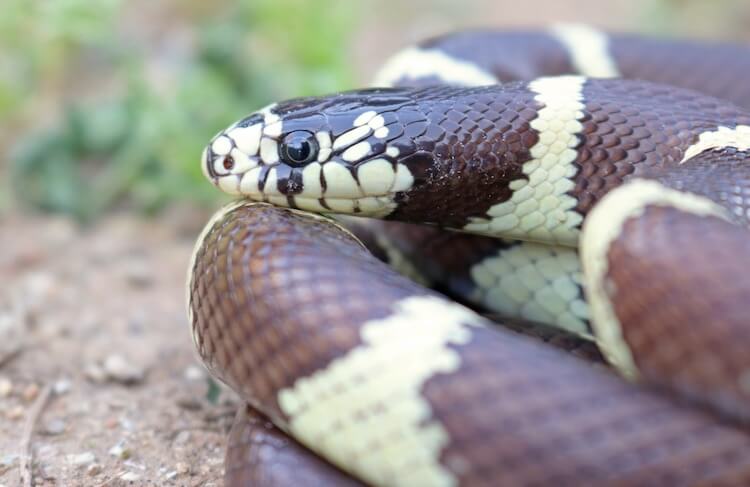
California Kingsnakes typically cost $50 to $100.
Rarer morphs such as the banana will cost closer to $200.
Before purchasing a Kingsnake it is important to examine them for any health abnormalities. You should check their eyes, ears, mouth and vent for debris or secretions. This is often one of the first signs of health issues.
California Kingsnakes are relatively easy to find and can be purchased from many pet stores.
It is best to buy them from a reputable breeder. This will ensure that they are free of parasites and have a more docile and manageable temperament.
Facts
| Common Name | California Kingsnake |
|---|---|
| Scientific Name | Lampropeltis getula californiae |
| Price | ~$100 |
| Size | Three to four feet long |
| Lifespan | 20 to 30 years |
| Diet | Mice, chicks and lizards |
| Tank Size | 40-gallon wooden |
| Humidity & Temperature | Daytime temperature: 75 – 80°F Basking Spot: 88 – 90°F Humidity: ~50% |
| Popular Alternatives | Corn snakes, other subspecies of Kingsnakes |
Summary
California Kingsnakes are one of the most popular pet snakes.
They are docile yet peppy and thrive in a variety of habitats and enclosures.
Kingsnakes are suited for both first-time snake owners and those with prior experience. However, first-time owners should use long forceps when feeding to prevent accidental strikes.
The only drawback is their large size as some grow to be around six feet in length. Because of this some beginners prefer the smaller corn snake or ball python.
Do you own a species of Kingsnake? Let us know.

